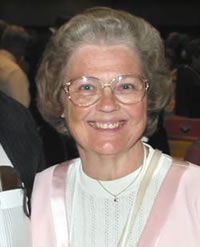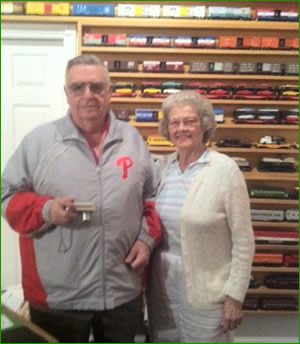My Introduction to TCA
By Christie M. Wilson
TCA National Secretary, #91-32878
I grew up in an old farmhouse, one with servants’ quarters in the rear upstairs of the house. There were no servants, but the rooms were still there, and inquisitive youngsters love to explore, so I did. One room contained a bed and a dresser; the other one had a very low bookshelf running all the way around the perimeter of the room. It had to be a bookshelf; it was lined with books – the complete Hardy Boys series, all the classics in maroon covers with gold embossed titles, etc., etc., etc.
So, being inquisitive, I asked my mother why the bookshelf was so low. She explained that it was a train layout. I couldn’t quite fathom that, so I continued with the questions. It turns out that my father had wanted a train set as a boy. Something about the electricity in the house didn’t allow for trains, so my father vowed that if he ever had a son, he would build that son a layout and run trains on it.
Well, my father DID build the layout, but my brother had NO interest whatsoever in toy trains. I didn’t know about this at all, because little girls played with dolls and helped their mothers in the kitchen back in those days. So, you ask, what happened to the trains? My cousins loved them, so my father gave them all the Lionel items, Plasticville houses, track, transformers – the whole shebang. And what did they do with them? They ran them until they wouldn’t run anymore and threw them away.
Fast forward. I had no more interest in the mysterious “train layout.” I was a reader, so I devoured the books. That and school kept me busy for several years. When I went to college, I met a young man (Gordon Wilson) who shared many of my interests. He, too, had grown up on a farm, though his farm was in North Jersey, whereas mine was in South Jersey. For him, “The City” was New York; for me, “The City” was Philadelphia. I went to “The City” for serious shopping; he went to “The City” for performances and sporting events. We dated for a while, married, and began teaching (Gordon taught music and I taught English) in a town in Southern New Jersey.
Five years later, we moved from that town to a larger town a bit closer to “culture.” There he could be active in the South Jersey Choral Directors Association, of which he became the President – not once, but twice. We purchased a large house with five bedrooms and an unfinished basement. Suddenly, we had to have a layout. Imagine my surprise to learn that a layout could be three feet high! Anyway, the layout progressed. We had a village, buildings, track, trains, and even a subway. The basement abutted one of the “bedrooms,” which we used as an office – huge desk, typewriter, telephone, books, and a varied assortment of “stuff” we used to create lesson plans and tests for the school in which we were teaching. That office had a closet. Sure enough, just like Joe McDoaks, we soon had a hole in the wall and trains running from one room to another. There were two shelves so the trains could run below the storage space in the closet.
Time passed. One day the smoke bulb for one of Gordon’s Lionel engines burned out. He sent me to a nearby establishment called “Antiques and Trains” to see if I could find a replacement bulb. There I was greeted by the owner, Rich Bimmer. He was just a fixture, however, in this huge two-story shop filled with toy trains on layouts and others in boxes for sale. The store included two stories of trains and parts and even a few antiques. My eyes must have been as wide as the proverbial “saucers.”
When I went home, with the smoke bulb in hand, I exclaimed, “You should see this place. It has EVERYTHING!” That was my undoing. I hardly ever saw Gordon after that. He worked at the train shop during every spare moment. He and Rich Bimmer became good friends, sharing not only a love of toy trains, but also music. Rich was a member of the Hobo Band, of which Gordon later became a Director. In fact, it was membership in this Hobo Band which allowed Gordon to go to the Baseball All-Star game in Philadelphia, because thy were an invited band to perform that day. Rich was one of the two signees on Gordon’s application to join TCA in 1976.
Gordon and I attended the Atlantic Division train meets, worked the Greenberg Shows on the East Coast, and enjoyed the company of train collectors throughout the Mid-Atlantic states. Gordon, always a prolific writer, wrote articles for the Atlantic Division newsletter, TCQuarterly, and the Greenberg publications. Gordon composed; I proofread. Together, we put out some incredible material and Gordon gained a reputation as a toy train author. Many weekends, we journeyed to North Jersey (where his parents still lived) to attend an opera, play a concert, and attend one or two train shows.
Gordon was a demanding choral director, expecting performance from his students and perfection for himself. He felt that a Sabbatical Leave of Absence to study Choral Conducting Techniques would help him get a better sound from his high school choir. Off he went to Arizona State University. There his courses were at night, so he spent his days playing golf, attending baseball games, and chasing toy trains. In Arizona the train collectors had two meets a month, one every two weeks. Gordon met many train collectors during his Sabbatical. He returned with a straight A average in his classes and many tales about his toy train adventures in the desert. He began to talk about moving to Arizona. That didn’t appeal to me, as I readily told him, “You won’t like it. There are only 25 toy train collectors in the whole state.” Needless to say, I was wrong.
At any rate, eventually we DID retire from New Jersey and moved to Arizona. As soon as we arrived, Gordon was asked to be the Secretary of the Desert Division. This he did, with me behind him all the way, typing his material on our Selectric typewriter. Later we purchased a computer, so the Selectric was retired. For nearly 25 years, we published the Dispatch, one of the finest Division publications in all of TCA. It became widely accepted that Gordon had a typist and a proofreader – me. I served as Gordon’s secretary as he became President of the Desert Division and later President of TCA. My secretarial skills came in handy in publishing the Division Dispatch, keeping the minutes, and remembering details which most members soon forgot. Soon I was tapped to become Secretary of the Division. This I did for ten years. When the Desert Division hosted a TCA National Convention in 1997, I served as the Convention Secretary; when we hosted a second one in 2009, I was dubbed “Convention Scribe.”
So there you have it. Behind every good man there’s a woman. I am that person. I supported Gordon in all his endeavors – in his teaching, his concerts, his writing, his hobbies, and his love of travel. Every trip to York, every summer trip to a TCA National Convention, every adventure to a foreign land inspired me to be more productive. I kept scrapbooks for every trip we took. They still line a shelf in our “Phillies Room.”
This is my training to be the TCA Secretary. I have no formal classes, no shorthand, no schooling in secretarial practices. I went from a typewriter (a Christmas present I begged for in 1956) to an electronic typewriter (purchased from the school’s retired equipment in 1972) to a computer, and I joined the 21st Century. Today I serve as the TCA’s National Secretary, a position I’ll continue to hold as long as they want and need me.







